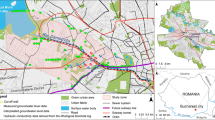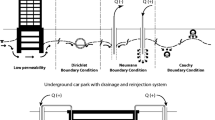Abstract
The interaction between the underground infrastructure and groundwater generates hydrogeological problems in Bucharest city (1.9 million people/228 km2 surface). One is the barrier effect produced by an extensively channelized river, increasing consequently the groundwater hydraulic heads in the surrounding areas. A second one is due to the strong hydraulic interaction between sewerage and the groundwater. As result, the seepage into the sewer network increases the influent flowrate received by the waste water treatment plant. Restoration of the sewer conduits triggers consequently the groundwater hydraulic heads increase. Answers to these problems have been foreseen by developing the Bucharest city hydrogeological model with the support of several institutions, companies, and experts. As a first step the 3D geological model, for the first 50 m below ground level, has been developed. The spatial intersection between the urban infrastructure elements (subway, parking lots, etc.) and the geological model, provided the geometrical parameters needed to quantify their groundwater flow barrier effect. It also enabled to identify the location of the sewer conduits and their potential hydraulic connection with the aquifer strata. The hydrogeological model englobes the following datasets: hydraulic heads, surface water, groundwater recharge from precipitation and from the water supply system losses, drainage systems and seepage into tunnels. The resulted hydrological water balance identified that about 0.92 m3/s wastewater surplus originates from seepage. It has been determined that more than 20% (96.7 km) of the sewer network is completely or partially immersed into groundwater. Scenarios to neutralize the groundwater sink impact have been simulated.
Access provided by Autonomous University of Puebla. Download conference paper PDF
Similar content being viewed by others
Keywords
1 Introduction
Water resources management in urban areas has to include the interaction between the underground infrastructure and the groundwater. This can be performed only by using modeling. The models can provide truthful results if they are based on accurate data and they properly reproduce the hydraulic and the hydrological processes.
Two main groundwater related problems produced by the interaction between the aquifer system and the underground infrastructure could be found in Bucharest, a city of about 1.9 million inhabitants that covers a surface of about 228 km2. The barrier effect produced by the extensively channelized Dambovita River that cuts Bucharest city, from NW to SE, is one of them (Fig. 1a). Consequently, it increases the groundwater hydraulic heads in the surrounding areas. Aging process of the sewer conduits, the second problem, produced a strong hydraulic interaction between the sewer system and the groundwater. If the seepage into the sewer network increases considerably the wastewater flow rates, the possible refurbishment of the conduits could further increase the already high groundwater levels in several city centre districts.
2 Materials and Methods
2.1 Urban Subsurface Analysis Steps
The Bucharest city urban hydrogeological model (CCIAS 2013) has been developed within an interdisciplinary research project. Institutions, companies, and experts brought data and knowledge to perform this work. An accurate 3D geological model (Serpescu et al. 2013) focusing the Quaternary sedimentary deposits of the first 50 m below ground level has been developed. It was used to delineate and hydraulically characterize the shallow aquifer system composed by the first two shallow aquifer layers, separated by an aquitard. Further, these units have been spatially intersected (Fig. 1b) with the subsurface urban infrastructure (3D sewer system, 3D subway network, etc.).
2.2 Characteristics of the Bucharest City Urban Groundwater Modelling Process
The initial main objective of the groundwater flow model focused the quantitative assessment of the groundwater-sewer system interaction. The model has been developed considering the sewer conduits larger than 400 mm in diameter. It has been developed on the basis of the above mentioned 3D geology - infrastructure geometrical intersection result.
The first step was to quantify the sewer conduits hydraulic connection with the aquifer strata as well as to assess the groundwater flow barrier effect (Boukhemacha et al. 2015) induced by different civil engineering works (subway, underground parking lots, and others). For the numerical integration of the model, in steady state conditions, has been used the finite difference method within Modflow solver (Harbaugh et al. 2000). Several realizations of the urban groundwater model, focusing on the interaction between urban infrastructure and the groundwater, were carried out for May 2013, December 2014, and October 2015.
The hydrogeological model has been developed by enclosing the following datasets: hydraulic head data, surface water levels, groundwater recharge coming from precipitation as well as from the water supply system distributed losses, drainage systems and seepage into the subway tunnels. The water supply operator estimated that the total losses from the entire water supply network of the Bucharest city are about 2.42 m3/s. These losses are coming from the following distinct subsystems: (a) Industrial water system (0.02 m3/s); (b) Aqueducts (0.098 m3/s); (c) Low pressure pipes (1.93 m3/s); and (d) High pressure pipes (0.38 m3/s). Groundwater recharge from the water supply network has been considered 70% of the total water losses. This contribution has been introduced as a recharge rate into the hydrogeological model.
The interaction between groundwater and sewer system has been modelled using the leakage factor approach. This approach is based on the assumptions that sewers conduits might have defects showing a uniform distribution along each conduit and the defect area is proportional to the sewer wetted perimeter. In addition, the sewer conduits in the aquitard are subjected to exfiltration only and all other conduits can exhibit infiltration or exfiltration. To use this approach, the location of each sewer pipe into the aquifer system had to be identified. The assumption that each sewer conduit is leaking has been made for the conduits located into the aquitard units. Leakage or groundwater seepage into the conduits could occur for those crossing the aquifer units.
The hydraulic function of the sewer conduit (leak or groundwater seepage) is dependent on the position within the aquifer system (Fig. 1b). The exchange with groundwater was modelled by dividing the sewer system conduits into two categories: sewer conduits located entirely into the aquitard and sewer conduits located partially or totally into the upper aquifer. Hydraulic modelling details are given by Boukhemacha et al. (2015).
The groundwater recharge from precipitation has been estimated using the SCS-Soil Conservation Service- model (US Department of Agriculture 1954) adapted for urban conditions. The recharge of the upper aquifer unit coming from rainfall was quantified using the mean multi annual precipitation rate of 600 mm/year.
Several subway tunnels and stations cross the study zone (Fig. 1a). These elements have the barrier and drainage effects in relationship to groundwater. The drainage effect is due to groundwater seepage into tunnels. The subway operator reports annually a value of 0.08 m3/s as the mean total seepage flow rate. This effect has been taken into consideration into the hydrogeological model as a specified flow rate distributed along the subway network. The barrier effect consists of total or partial obstruction of the groundwater flow, causing a local oscillation of the hydraulic head as well as a variation of the natural flow direction.
3 Results and Discussion
For the entire city sewer system, the hydrogeological model predicts a total infiltration flow rate of about 1.326 m3/s from groundwater. The infiltrating sewer conduits are completely or partially located into the shallow aquifer unit, therefore they are partially or entirely immersed. The model also predicts a total leakage of about 0.41 m3/s for the entire city sewer network. This flow rate represents about 3.4% of the dry weather flow. The difference between the groundwater seepage and sewer network leakage, for the entire network, gives the total inflow rate of about 0.92 m3/s as a result of the exchange between groundwater and the sewer conduits. This additional flowrate is received by the Bucharest city wastewater treatment plant, able to treat a maximum of 9 m3/s.
The results allowed also the identification of the sewer conduits showing a possible hydraulic interaction with groundwater. The sewer segments showing leakage conditions can be classified function of their position into the geological matrix (Fig. 1b). The sewer segments presenting leakage conditions are located totally or partially into the shallow aquifer unit and they could be partially immersed or located above the water table. There are also sewer segments located into the aquitard units but the leakage rates are assumed to be insignificant. The sewer segments presenting groundwater infiltration conditions intersect the upper aquifer unit. These are totally or partially immersed into groundwater and the groundwater level is higher than the water level into the sewer. These segments are predominantly located along the Dambovița River.
The analysis of the sewer conduits location associated to the groundwater levels indicates that, if considering the total length of the sewer system (estimated to be about 474.3 km), about 16.9 km of sewer conduits are completely immersed into groundwater and about 79.8 km of the conduits are partially immersed. Thus, more than 20% of the sewer system is entirely or partially immersed into groundwater.
4 Conclusions
The urban hydrogeological model represents a powerful tool for urban groundwater management in Bucharest City. It allows simulations to assess the impact on the urban groundwater of the sewer system rehabilitation, the consequences of future underground works development (tunnels, building basements and deep foundations etc.), the effects of natural based solutions (green infrastructure) projects, and many others.
This project has been possible due to an institutional collaboration framework between the researchers, the city water operator, and other various institutions. This scientific partnership increased the model quality triggering additional studies related to hydrogeological and geotechnical topics, underground infrastructure development, groundwater protection and environmental impact.
References
Boukhemacha, M.A., Gogu, R.C., Serpescu, I., Gaitanaru, D., Bica, I.: A hydrogeological conceptual approach to study urban groundwater flow in Bucharest city, Romania. Hydrogeol. J. 23(3), 437–450 (2015). https://doi.org/10.1007/s10040-014-1220-3
Groundwater Engineering Research Centre, Technical University of Civil Engineering Bucharest – CCIAS: Hydrogeological flow model for the Moesic aquifer system (Bucharest Area). Research project: Sedimentary Media Modelling Platform for Groundwater Management in Urban Areas (SIMPA). – Scientific Report, No 10, Unpublished results, Bucharest (2013)
Harbaugh, A.W., Banta, E.R., Hill, M.C., et al.: MODFLOW-2000, the U.S. Geol Survey modular ground-water model - User guide to modularization concepts and the Ground-Water Flow Process. U.S. Geological Survey Open-File Report 00-92 (2000)
Serpescu, I., Radu, E., Gogu, C.R., et al.: 3D Geological model of Bucharest city Quaternary deposits. In: 13th SGEM GeoConference on Science and Technology in Geology, Exploration and Mining, vol. 2, pp. 1–8 (2013). https://doi.org/10.5593/sgem2013/ba1.v2/s02.001
US Department of Agriculture: National Engineering Handbook. Washington DC (1954)
Author information
Authors and Affiliations
Corresponding author
Editor information
Editors and Affiliations
Rights and permissions
Copyright information
© 2019 Springer Nature Switzerland AG
About this paper
Cite this paper
Gogu, C.R., Boukhemacha, M.A., Gaitanaru, D., Moraru, I. (2019). Interaction Between City Subsurface Infrastructure and Groundwater. In: Mannina, G. (eds) New Trends in Urban Drainage Modelling. UDM 2018. Green Energy and Technology. Springer, Cham. https://doi.org/10.1007/978-3-319-99867-1_36
Download citation
DOI: https://doi.org/10.1007/978-3-319-99867-1_36
Published:
Publisher Name: Springer, Cham
Print ISBN: 978-3-319-99866-4
Online ISBN: 978-3-319-99867-1
eBook Packages: EnergyEnergy (R0)





